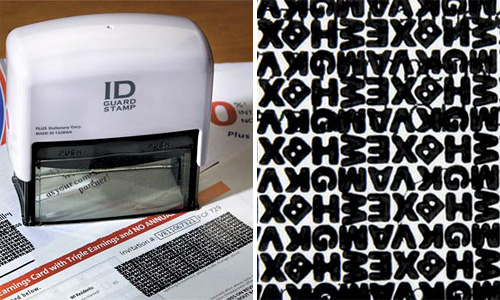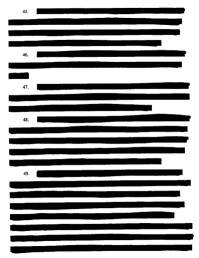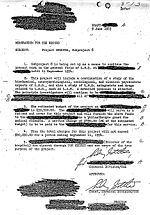Stamping Out the Evidence: Are Stampers a Viable Alternative to Shredders?
Some of the best ideas come from readers. Not long ago, E. emailed to say:
I recently found out there are stampers available that are supposed to obliterate your address and allow you to recycle paper that would ordinarily be shredded.
E. asked if I might review the various stampers for quality, and even provided links to multiple products like Plus ID Guard Stamp, XStamper’s Secure Stamp and ExcelMark’s Theft Protection Stamp) in case I might have an opinion on features or brands.

As I drafted my reply, I apologized in advance, because I knew my answer was probably not the one E. wanted to hear. More than anything, these stampers reminded me of the Unitasker Wednesday feature on Erin Doland’s excellent Unclutterer blog. They do one thing only, and not as well as an obvious alternative.
STAMPER VS. SHREDDER
First, I generally wondered under what conditions might one want to use a stamper to make a piece of paper recyclable, when shredding a piece of paper would accomplish the same thing with no fear of a reversal of the process (as happens with check washing). A good cross-cut shredder makes it impossible to recreate the original document’s information (and therefore, renders the paper useless to identity thieves, corporate espionage workers or the spies on Chuck), whereas inks can often be removed by an industrious thief.
Next, putting aside the question of recycling, I wondered under what circumstances I’d advise using a black-out stamper rather than a shredder to maintain the integrity of some of the written material, while making the rest opaque. This is done well by various governments, for example, when portions of documents are redacted to protect an individual’s privacy or to maintain classified information:


Nowadays, the government redacts documents electronically. Just as Paper Doll might use the highlighting function with a yellow background, one can redact the digital text with a black background like so: I bet you’re wondering what this says.
However, I’m dubious that this is a product that those of us not involved in government service or responsible for top secret information would find useful or help us be more productive. It’s far more likely that if we want to keep a document, we’ll want to see all of it, and if we no longer need it, we’ll be willing to destroy it in full.
I noted to E. that an address is a matter of public record, so obliterating it, alone (when there’s no Social Security or account number to hide), does little for protection against identity theft. Anyone can generally access that data as a matter of course via Google, SpokeO or any of a variety of search engines.
Finally, the idea of hand-stamping each convenience check sent by banks and credit card companies is exhausting. Feeding a short stack into the shredder and letting it nibble up 12 checks (and the accompanying hard-sell tactics) at one time seems eminently more appealing.
DO STAMPERS WORK?
Beyond the relative merits of shredders vs. stampers, there are practical considerations raised. I have three initial concerns:
1) Washability — A common type of fraud is check washing, where ink is removed from checks with the application of simple solvents like isopropanol or acetone, such as is found in nail polish remover. There are relatively few commercial inks that are not “washable”, which is why there is so much concern about check washing for identity theft purposes.
If a typical dye-based ink is used in the stamp ink, a determined thief can access the information below. Check washing, itself, can be averted by using gel-based inks that are not washable, but the makers of identity protection stampers don’t generally make known the contents of their inks, so it’s difficult to judge the merits of their formulas.
2) Adherence — At least one of the major brands even admits that their ink will not adhere to glossy paper, which eliminates the ability to obscure names and addresses from magazines covers, which are generally labeled electronically directly on the magazines, rather than on adhesive labels.
One of the major stamp manufacturer’s web sites states:
Not recommended for use on the following surfaces: Sealed postcards, coated paper, glossy paper and photo paper.
3) Security of Obscurity — The purpose of the ink is to obscure the text beneath. Even if the ink cannot be washed or wiped off, stamper ink is not exactly akin to blocking Superman’s X-ray vision with lead. Application of different wavelengths of light can render the obscured text visible. Sometimes, even a flashlight or light table (such as is used for viewing negatives or slides) will work.
One of the better-selling brands of privacy stamps promotes the product by saying, “Specially formulated ink ensures that addresses will not bleed through.” However, in an online review, a user states that she:
Another review of the same product stated that that ink could be wiped off glossy pages within 24 hours.
Treated paper (i.e., anything that is not fibrous, allowing the ink to soak into the paper), in general, can’t be easily sullied by stampers. So, the inking won’t obliterate information on glossy paper, and though it may do so on things like contracts or other legal or financial paperwork, a diligent identity thief might be able to wash the ink and get at the desired information. And again, if the written information were of a sensitive enough nature to keep private, you’d likely want to keep it intact in a safe deposit box or shred it completely once you no longer needed to maintain the complete document.
So, we’ve generally come full circle. Except…
A CAVEAT: PAPER DOLL‘S SHORTSIGHTEDNESS
When I originally replied to E.’s letter, I was thinking inside the (paper) box. Although E. did not state it, further research indicates to me that she might have been concerned about the wisdom of recycling shredded paper. According to Ecocycle.org, there are some lesser-known drawbacks to shredding:
- The length of a paper fiber determines its value, because longer fibers can be used to manufacture higher-grade papers and can be recycled more times. Thus, the tiny confetti-esque bits of cross-cut paper that do so much to protect our privacy aren’t necessarily stellar with regard to protecting the environment.
- The paper mills that purchase paper for the recycling process must do a “quality sort” before sending paper on to the giant paper-munching machines. Because it’s difficult to judge the quality of the smallest bits, they are often discarded and sent to landfills rather than processed for recycling.
- Recycling facilities often use filters to remove non-fibrous contaminants (like chunks of dirt, metal or plastic). Although this improves the end-quality of the recycled paper, due to the small size of shredded paper, the tiniest bits may be grabbed by the filters and discarded rather than recycled.
Because of these issues, it’s true that some communities will not recycle shredded paper, and some environmentally-minded consumers prefer not to shred if the paper can’t be recycled. However, other communities are happy to accept shredded paper to mix with other low-quality paper supplies. And, of course, Corporate America must, by virtue of operational security and various types of legislation, shred paper, such that document destruction companies like Shred Nations report recycling 10,000 tons of shredded paper each month.
Given the above, Paper Doll believes that if we did have to choose between ensuring high-quality protection against identity theft (via shredding) which might make recycling more difficult, and a lower-quality protection (via stamping) with what seems to be a negligible benefit in the enormity of the recycling process, shredding beats stamping. No contest.
However, as with most things, there is a middle ground to consider. First, check to see if your community is able to recycle the shredded paper you discard — you may be pleasantly surprised. Second, residential shredding refuse is minimal compared to that used by businesses, meaning that the impact of shredding your household’s documents is a drop in the ocean compared to the impact of big business.
If you are concerned enough about the environment to be considering stampers in lieu of shredding for environmental reasons, why not contact local business-oriented document destruction companies in your area to see whether they currently recycle the paper they collect and shred?
SPECIAL CIRCUMSTANCES
Let’s say you were thinking about donating a magazine to a medical office, hospice or homeless shelter, or somewhere else where a number of persons unknown to you would have the opportunity to view your name and address. While the likelihood of opportunistic identity theft is always greater than zero, it’s easily avoided. Before donating magazines, simply cut out the address label portion. It prevents people from knowing your name and address if all they have is the magazine, and always works, unlike the stampers, which will not work on glossy or film-based paper. The reverse of the cover page is almost always an advertisement, eliminating any chance you’ll reduce the next reader’s enjoyment.
Sometimes, you might wish to obscure personal data in order to post scans or photos of mail or documents to a blog or website. If you’re involved in these types of creative endeavors, I’d encourage you to scan the item first, then use photo software or applications (like MS Paint or iPhoto) to “spray-paint” and blur or cover the data you want hidden.
SUMMARY
Going back to E.’s original inquiry then, I maintain that there’s relatively little reason to obscure information like a name and address, anyway, but no matter how remotely sensitive the information you hope to conceal might be, identity protection stampers seem like a particularly weak and non-permanent solution. In essence, then, Paper Doll feels that a simple, portable and less expensive option, a black Sharpie, will succeed in doing all that these stampers can (if you’re merely trying to hide information from a casually curious observer), while a decent shredder will provide so much more protection against any intentional ne’er-do-well.
It’s a rarity that Paper Doll speaks ill of a product; I usually keep silent if I don’t have anything positive to say. But, because I was asked, I have to say that I found little to endear me to privacy stamps. However, I invite readers to comment and let me know if you think I might be off-base. Please feel free to stamp out my opinion, and share your own.




[…] so the papers don’t need to be shredded. If you’re considering this approach, I recommend organizer Julie Bestry’s comprehensive look at the pros and cons of using these […]
We take telephone and mail orders with credit card information included. We need to keep the order information for a certain period of time; but to be PCI compliant, we must obliterate the credit card information. A stamper works well for us. The paper used to take the order is porous so the ink does not wipe off. The stamps do have their place in protecting information.
[…] so the papers don’t need to be shredded. If you’re considering this approach, I recommend organizer Julie Bestry’s comprehensive look at the pros and cons of using these […]
Shred sensitive papers and compost. Good for the enviroment, ditto the garden and 100 percent secure. Job done!
Hi, Peter, thanks for your thoughts. Your points are apt, and readers know I’m a big fan of shredding, but composting tends to be a solution for people already in an advantaged situation.
While composting is a lovely option for those who can use it, according to the US Census Bureau, 63% of the American population lives in urban areas, and while some of those actually live in suburbs and are counted as urban, still, a huge percentage of the population owns no land and has no opportunity to compost. I live in a relatively surburban area, but am a renter, and similarly cannot compost because I have no property beyond the door to my home, with the exception of a tar-covered parking space. No grass, no trees, no garden, no ground. So, sadly, no composting.
I received the ID protector stamp and two refills as a gift. The person who gifted the item to me does not have the receipt any longer. It is brand new sealed in the plastic in the Box and it isn’t working. When you go to stamp the paper the actual pad is not touching the paper to apply the ink to. Has anybody else ran into this and other than replacing it what did you do to get it to work?
Hi, Flo:
Thanks for posting your question. This post, noting that I didn’t think that stampers were a good idea, is from NINE years ago, so I don’t anticipate you’re going to find many people seeing your question and replying. I mean, my blog is informative, but I don’t imagine a lot of people are reading my nine-year-old posts, let alone reading the comments. (But folks, hurray if you are!)
My suggestion is that you call the manufacturer. Different companies make these stampers, but if you Google the name of the company named on the box, there should be a customer service number. My guess is that if the stamp isn’t touching the paper and there’s no adjustment mechanism, that you just received a bad product. Good luck.
What a detailed article! I got some outstanding ideas from it! Really it is very important to know the basics of shredder. as a buyer I have to do much research on some good topics. The shredder is my present topic of research. Whatever, very much pleased to get such outstanding ideas! Thanks for them!
I was wondering about prescription labels that are actually in the bottles. Would you recommend, removing labels if easy enough, placing them on other piece of paper, then shred that page?
Open to suggestions. I do often just remove the address or offer part if junk Mail and then shred it.
Great Article. Thanks.
Some pharmacies use adhesive labels that can be removed easily by just peeling them off. With those, I suggest just peeling and ripping the label a few times. The effort of attaching it to paper and then shredding that paper seems excessive unless someone has an extreme reason to fear a dumpster diver knowing what medication they take. Unless you are a celebrity or politician, just pulling the label and crumpling it into a sticky ball or ripping it into a few pieces should suffice. You’re right that you can’t just shred the little labels on their own; attaching them to paper will enable them to run through the shredder. But again, save that effort unless the consequence of dumpster divers knowing your prescription history would be tragic or problematic for you.
If the labels are not easily removed, I encourage you to fill a bowl or dishpan with hot soapy water and toss your bottles in there. They’ll float, so you may want to put a small pot lid or dessert plate on top to keep them submerged. Come back later and use a brush or scrubby pad to rough up enough of the label to obscure your name. (There’s no need to remove all the information, just your name, to ensure your privacy.)
As for address labels on subscriptions or junk mail, there’s no need to shred your address, as it’s a matter of public record. If you own your home, are a registered voter, or are otherwise an “official” resident of where you live, the combination of your name and address are far more easily found with a quick Googling than dumpster diving. DO shred convenience checks or anything with your ACCOUNT NUMBERS or SOCIAL SECURITY numbers, but shredding address labels really is a waste of your energy, in my opinion.
Thanks for reading!